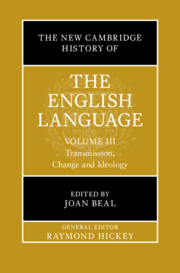Book contents
- The New Cambridge History of the English Language
- The New Cambridge History of the English Language
- The New Cambridge History of the English Language
- Copyright page
- Contents
- Figures
- Tables
- Contributors to Volume III
- General Preface
- Abbreviations
- General Editor’s Introduction
- Introduction to Volume III
- Part I The Transmission of English
- Part II Tracking Change in the History of English
- 6 Spelling Practices and Emergent Standard Writing
- 7 Phonological Change
- 8 Applying Historical Phonology
- 9 The Emerging Phonological Standard
- 10 The History of R in English
- 11 The System of Clausal Complementation
- 12 Tense, Aspect and Modality in the History of English
- 13 Developments in the Passive Construction
- 14 Adverbs in the History of English
- 15 The Story of English Negation
- 16 Dative and Genitive Variability in the History of English
- 17 Relativisation
- 18 Recent Grammatical Change in English
- 19 The History of English Registers
- 20 The History of Semantic Theory
- 21 The Development of Pragmatic Markers
- Part III Ideology, Society and the History of English
- Index
- References
11 - The System of Clausal Complementation
from Part II - Tracking Change in the History of English
Published online by Cambridge University Press: 23 October 2025
- The New Cambridge History of the English Language
- The New Cambridge History of the English Language
- The New Cambridge History of the English Language
- Copyright page
- Contents
- Figures
- Tables
- Contributors to Volume III
- General Preface
- Abbreviations
- General Editor’s Introduction
- Introduction to Volume III
- Part I The Transmission of English
- Part II Tracking Change in the History of English
- 6 Spelling Practices and Emergent Standard Writing
- 7 Phonological Change
- 8 Applying Historical Phonology
- 9 The Emerging Phonological Standard
- 10 The History of R in English
- 11 The System of Clausal Complementation
- 12 Tense, Aspect and Modality in the History of English
- 13 Developments in the Passive Construction
- 14 Adverbs in the History of English
- 15 The Story of English Negation
- 16 Dative and Genitive Variability in the History of English
- 17 Relativisation
- 18 Recent Grammatical Change in English
- 19 The History of English Registers
- 20 The History of Semantic Theory
- 21 The Development of Pragmatic Markers
- Part III Ideology, Society and the History of English
- Index
- References
Summary
This chapter addresses the history of the English system of clausal complementation. It is organised around four major questions. First, where do complement clauses (or CCs) come from? The history of English indicates that adverbial clauses can turn into CCs (e.g. lest-complements), or phrasal units undergo clausalisation (e.g. the gerund) – or both these mechanisms come into play (e.g. the to-infinitive). Second, what changes can CCs undergo? Changes to CCs may affect their internal syntax. For example, subjectless non-finite clauses have a strong tendency to develop subjects (e.g. ECM constructions, for…to-infinitives, secondary predicates). Often, CCs also undergo distributional change as they spread to new CC-taking predicates. The characteristic pattern is one of lexical diffusion. Third, how does the system change as a whole? English sees an unmistakable trend towards more non-finite complementation – a development known as the ‘Great Complement Shift’. This leads to a great number of variation hotspots, where finite CCs compete with non-finite alternatives, or non-finite alternatives compete among themselves. Fourth, what eventually becomes of CCs? At least two pathways of change appear to be open to CCs. In both cases CCs become more main-clause like. Either the matrix clause develops into an operator (i.e. an auxiliary or parenthetical), or the matrix clause disappears altogether, leading to insubordination.
Keywords
Information
- Type
- Chapter
- Information
- The New Cambridge History of the English LanguageTransmission, Change and Ideology, pp. 301 - 325Publisher: Cambridge University PressPrint publication year: 2025
References
Accessibility standard: WCAG 2.0 A
Why this information is here
This section outlines the accessibility features of this content - including support for screen readers, full keyboard navigation and high-contrast display options. This may not be relevant for you.Accessibility Information
Content Navigation
Allows you to navigate directly to chapters, sections, or non‐text items through a linked table of contents, reducing the need for extensive scrolling.
Provides an interactive index, letting you go straight to where a term or subject appears in the text without manual searching.
Reading Order & Textual Equivalents
You will encounter all content (including footnotes, captions, etc.) in a clear, sequential flow, making it easier to follow with assistive tools like screen readers.
You get concise descriptions (for images, charts, or media clips), ensuring you do not miss crucial information when visual or audio elements are not accessible.
You get more than just short alt text: you have comprehensive text equivalents, transcripts, captions, or audio descriptions for substantial non‐text content, which is especially helpful for complex visuals or multimedia.
Visual Accessibility
You will still understand key ideas or prompts without relying solely on colour, which is especially helpful if you have colour vision deficiencies.
Structural and Technical Features
You gain clarity from ARIA (Accessible Rich Internet Applications) roles and attributes, as they help assistive technologies interpret how each part of the content functions.
